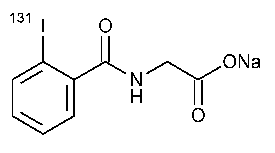Iodohippurate Sodium I131Injection
Glycine,N-[2-(iodo-131I-benzoyl)-,monosodium salt.
Monosodium o-iodo-131I-hippurate [881-17-4].
»Iodohippurate Sodium I131Injection is a sterile solution containing o-iodohippurate sodium in which a portion of the molecules contain radioactive iodine (131I)in the molecular structure.
Iodohippurate Sodium I131Injection contains not less than 90.0percent and not more than 110.0percent of the labeled amount of 131Ias iodohippurate sodium expressed in megabecquerels (microcuries or millicuries)per mLat the time indicated in the labeling.Other chemical forms of radioactivity do not exceed 3.0percent of the total radioactivity.
Packaging and storage—
Preserve in single-dose or in multiple-dose containers.
Labeling—
Label it to include the following,in addition to the information specified for Labelingunder Injections á1ñ:the time and date of calibration;the amount of 131Ias iodohippurate sodium expressed as total megabecquerels (microcuries or millicuries)and as megabecquerels (microcuries or millicuries)per mLat the time of calibration;the expiration date;and the statement “Caution—Radioactive Material.”The labeling indicates that in making dosage calculations,correction is to be made for radioactive decay,and also indicates that the radioactive half-life of 131Iis 8.08days.
Radionuclide identification (see Radioactivity á821ñ)—
Its gamma-ray spectrum is identical to that of a specimen of iodine-131of known purity that exhibits a major photopeak having an energy of 0.364MeV.
Bacterial endotoxins á85ñ—
The limit of endotoxin content is not more than 175/VUSP Endotoxin Unit per mLof the Injection,when compared with the USP Endotoxin RS,in which Vis the maximum recommended total dose,in mL,at the expiration date or time.
pHá791ñ:
between 7.0and 8.5.
Radiochemical purity—
Place 1drop of a solution containing 0.2percent potassium iodide,1.0percent sodium bicarbonate,and 1.0percent sodium thiosulfate,about 45mm from one end of each of two 25-×300-mm strips of chromatographic paper (see Chromatography á621ñ),and allow to dry.Superimpose on one of the spots a measured volume of Injection,appropriately diluted,such that it provides a count rate of about 20,000counts per minute,on this point of application,and allow to air-dry.Superimpose on the second spot 100µLof a solution prepared by dissolving 50mg of non-radioactive iodohippurate sodium in 10mLof alcohol,and allow to air-dry.Develop the chromatogram over a period of about 2½hours by descending chromatography,using the upper layer obtained by shaking together 2volumes of benzene,2volumes of glacial acetic acid,and 1volume of water.Use the aqueous layer to equilibrate the apparatus prior to the start of development.Dry the chromatogram in air,and determine the radioactivity distribution by scanning the chromatogram with a suitable collimated radiation detector.Locate the position of the non-radioactive spot by viewing the chromatogram under short-wavelength UVlight.The radioactivity under the iodohippuric acid band is not less than 97.0%of the total radioactivity,and its RFvalue is within ±10%of that of the non-radioactive spot.
Other requirements—
It meets the requirements under Injections á1ñ,except that the Injection may be distributed or dispensed prior to the completion of the test for Sterility,the latter test being started on the day of final manufacture,and except that it is not subject to the recommendation on Volume in Container.
Assay for radioactivity—
Using a suitable counting assembly (see Selection of a Counting Assemblyunder Radioactivity á821ñ),determine the radioactivity,in MBq (µCi)per mL,of Injection by use of a calibrated system as directed under Radioactivity á821ñ.
Auxiliary Information—
Staff Liaison:Andrzej Wilk,Ph.D.,Senior Scientific Associate
Expert Committee:(RMI)Radiopharmaceuticals and Medical Imaging Agents
USP28–NF23Page 1035
Phone Number:1-301-816-8305
